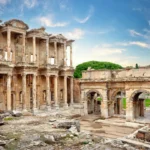The history of the Jews in Izmir goes back to the period before Christ. Although it is not known when the Jews settled here for the first time, there are some records that ensure that the first settlements occurred in 530 BC. during the Babylonian Captivity. Not all the Jews returned to Palestine and those who were content with their standards stayed where they had fled. Among these places is considered Izmir.
However, the largest migration of Jews to and around Izmir was that of the Sephardim and it occurred after their exile from Iberia in the late 15th century and after that they carried out their religion and commercial activities freely for hundreds of years under the protection of the Ottoman Empire and reached important places at the state level.
At the end of the 19th century AD. there were more than 15,000 Jews and 50 synagogues in the center of Izmir. After migrations to Europe, the United States, and Israel in 1948, its population dropped to 2,500. Today 1,300 Jews live in Izmir and the city has several synagogues.
Bikur Holim Synagogue
In 1724, a Jew named Salamon de Ciaves, a Dutch immigrant of Portuguese origin, donated one of his houses with a large garden on İkiçeşmelik road to be used as a synagogue and donated some of the houses and shops adjacent to it. to the synagogue to bring him income.
The basement of this synagogue, also known as the Çaves Synagogue, was used as a hospital during one of the frequent plague or cholera epidemics in the city, and from then on it was renamed the Bikur Holim Synagogue, which means “visit to the sick.” Burnt down in 1772, the synagogue was rebuilt in 1800 by Manuel de Ciaves, a member of the same family.
With its central prayer area, its roof designed with flowers and fruit, and its ornate columns painted in green and yellow, it is one of the most beautiful places of worship in the city.
Etz Hayim Synagogue
It is considered one of the first synagogues in Izmir and was built during the Byzantine era. It received damage during the fire of 1841 and was restored in 1851.
The ground floor of the Etz Hayim Synagogue is made of masonry stone and the upper floor is made of wooden frames. The ceiling coverings and intermediate walls are made of wood, and the floor is made of marble. The prayer area, located in the center of the synagogue, is surrounded by four columns that divide the roof into nine rectangular pieces and support the weight of the roof. Above the links between these columns are the Hebrew verses from the Torah. The roof of the prayer area is green and has flower decorations. Rows of seats surround the prayer area. The women’s room is on the top floor of the star-adorned entrance. There are six Torah cabinets in the synagogue.
Sinyora Giveret Synagogue
It was built in the 16th century by Donna Gracia Mendes, a Portuguese merchant. It received extensive damage from the fire of 1841 and was restored by the Yerushalmi family. It was designed with a central plan. The new floor plan was also tested in this synagogue, which began to be implemented with the Italian influence in the 20th century. It is located in Kemeralti, one of the most popular and historic markets in the city. It was built with stones and bricks and has a rectangular plan.
Shalom Synagogue
Known as the Kal de Abaşo or the Kal de la Tromba, and also as the Synagogue of the Jews of Aydın, after being assigned to the Jews of Aydın in the 1930s, it was one of the six synagogues existing in 1610. It was known that Sabbatai Sevi proclaimed himself the ‘Messiah’ in this synagogue. The dates 5560 (1800) and 5650 (1890) recorded in the synagogue courtyard inscription are likely the dates of major repairs and renovations. After the great fire of 5760 (1841) burned the entire neighborhood, it stopped at the door of this synagogue.
The interior of the Şalom Synagogue, which can be called the most authentic synagogue in Izmir, reminds us of a Turkish house with its ceilings decorated with hand-drawn works, ottomans on the lower part of the walls, and flowery cushions. The synagogue’s prayer area, resembling the prow of a galleon, was once in the center but probably retracted to the wall in the early 20th century. The classic triple composition of the cabinet where the Torah scrolls are kept can also be seen in this synagogue.
A portion of the synagogue’s front lawn was reserved for Ashkenazi Jews in the early 20th century, and when they left, it was converted into a store. In the garden there is a gazebo with a large crown in the middle of which is said to be the only one in the world.
Rosh Ha Har Synagogue
It is one of four synagogues built at the end of the 19th century when Jews began to settle in the newly established neighborhoods of Güzelyalı, Karataş, Asansor and Halil Rıfat Paşa. It is also popularly known as the La Montaña Synagogue.
The place of worship is covered with a hipped roof. In the main space, whose floor is paved with Italian tiles, the carved wooden hexagonal prayer area with two steps and the cabinet where the Torah scrolls are kept with three steps are striking.
This charming little synagogue in the Yukarı Karataş neighborhood, whose construction date is unknown, is only open during the festivities.
Beth Israel Synagogue
It is located in the Karataş neighborhood, on Mithatpaşa street and was inaugurated in 1907. It was built due to an edict addressed to the former Grand Vizier Kamil Pasha, the Governor of Izmir at that time, by Sultan Abdülhamit II, for the worship of the Jews who lived in the Karataş neighborhood. It is the largest Jewish place of worship in the city. In the 1950s, it was restored by Avraam Rubi Gizbar and turned into its present form. In 2007, the centennial of the synagogue was celebrated with a series of events.




